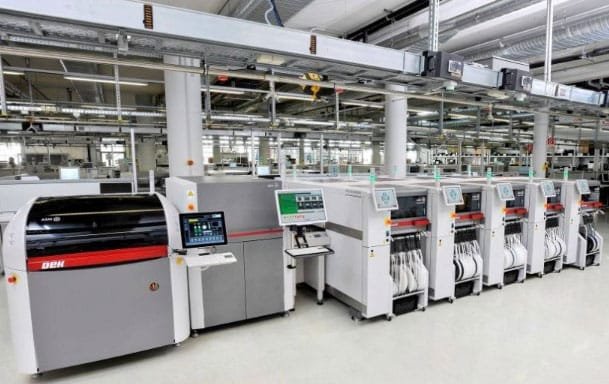
Normes opérationnelles clés pour Équipement SMT
- 1. Les opérateurs SMT doivent posséder un sens aigu des responsabilités et travailler avec soin et diligence.
- 2. Les opérateurs doivent suivre une formation systématique dispensée par le service d'ingénierie avant de commencer leurs fonctions, y compris une formation sur la discipline des processus et la sécurité de la production.
- 3. Les opérateurs doivent réussir une évaluation et obtenir une qualification avant d’être autorisés à utiliser l’équipement SMT.
- 4. Les nouveaux opérateurs doivent être supervisés par un mentor pendant leur période initiale d’exploitation.
- 5. Respectez strictement les procédures décrites dans le « Manuel d’utilisation de l’équipement », avec les documents de processus requis affichés avant le début de la production.
- 6. Il est interdit d'accéder ou de modifier des menus qui ne sont pas pertinents à la production ; tout réglage en cas de pénurie de matériel doit impliquer le personnel d'ingénierie.
- 7. Il est strictement interdit d'installer des racks de matériaux pendant le fonctionnement de la machine. Les capots de sécurité doivent être ouverts lors de l'installation d'un nouveau rack et les alimentateurs appropriés doivent être utilisés.
- 8. Ne jamais étendre aucune partie du corps dans l'enceinte de sécurité de la machine pendant son fonctionnement.
- 9. Il convient de veiller à éviter toute manipulation brutale ; les supports de matériel doivent être positionnés de manière ordonnée et sécurisée.
- 10. Les opérateurs ne doivent pas quitter l'atelier pour prendre leurs repas ou terminer leur quart de travail pendant que l'équipement SMT est en fonctionnement.
- 11. Tout message d'erreur provenant de l'équipement SMT doit être examiné attentivement. Les opérateurs doivent consulter le personnel technique en cas de message ambigu.
- 12. Effectuer les tâches quotidiennes de nettoyage et d’entretien conformément au « Manuel d’entretien de l’équipement » et s’assurer qu’elles sont documentées et vérifiées par le personnel technique.
- 13. Les changements matériels dans la production doivent être documentés et la confirmation par IPQC doit avoir lieu dans les 15 minutes pour garantir la cohérence.
- 14. L'écran d'affichage de production de l'équipement SMT doit généralement indiquer un état de projection de matériau et toute anomalie doit être signalée immédiatement.
- 15. Un seul type de matériau doit être stocké par ligne de production ; tout matériau restant doit être retourné au poste de travail avec suffisamment de ruban adhésif vide réservé.
- 16. Efforcez-vous de rassembler tout le matériel nécessaire au début du quart de travail afin de minimiser les interruptions pour du matériel supplémentaire.
- 17. Préparez-vous à l’avance aux changements de matériaux pour réduire les temps d’arrêt.
- 18. Les bobines de matériaux vides doivent être placées à l'emplacement désigné pour faciliter la vérification IPQC.
- 19. Tenir des registres de production ponctuels comme prescrit.
- 20. Remplissez les registres des temps d’arrêt avec précision et en détail, conformément à la réglementation.
- 21. À la fin du quart de travail, remplissez les dossiers détaillés d'informations de production et faites-les confirmer par l'opérateur et le personnel d'ingénierie qui arrivent.
- 22. Nettoyez la zone, jetez les matériaux utilisés et maintenez le principe 5S avant de partir.
- 23. Effectuez un inventaire des matériaux importants avec l’opérateur suivant à la fin du quart de travail.
- 24. Remplissez les dossiers de transfert conformément aux directives prescrites à la fin du quart de travail.
- 25. Les matériaux et les enregistrements d'outils doivent être stockés dans des zones désignées ; évitez l'encombrement des machines.
- 26. Le ruban usagé doit être coupé rapidement, à une longueur spécifiée pour éviter qu'il ne traîne dans la corbeille à déchets tout en garantissant la sécurité de la machine.
- 27. Terminez tous les tableaux de production encore en cours avant de partir pour un repas ou une pause.
- 28. Tout équipement anormal doit être signalé ; s'il y a un avertissement rouge, le personnel technique doit résoudre le problème avant réutilisation.
- 29. En cas d’accident d’équipement, la scène doit être préservée sans aucune excuse pour altération.
- 30. Lors de l'arrêt de l'équipement SMT, cela doit être effectué selon les procédures normales, en revenant au point d'origine de la machine pick-and-place.
- 31. Si un placement manuel est nécessaire en raison de limitations de l'équipement, il doit être confirmé par le personnel d'ingénierie sur site, en suivant l'ordre de placement de la machine avant le placement manuel.
- 32. Avant les changements d'équipe ou de production, les « trois vérifications » doivent être effectuées : vérifier l'absence de corps étrangers à l'intérieur de la machine, s'assurer que la largeur du rail est adaptée et vérifier que la plate-forme d'accouplement du rail est dans une position sûre.
- 33. Pendant la production initiale, surveillez de près l'utilisation du matériau, le flux et le positionnement du substrat dans la machine.
- 34. Les opérateurs doivent porter des gants antistatiques lors de la manipulation des circuits intégrés pendant la production.
- 35. Les produits NG présentant des défauts doivent être enregistrés conformément aux normes IPC, et toutes les cartes comportant deux unités défectueuses ou plus doivent être isolées pour une production séparée.
Ce document décrit les normes et directives d'exploitation des équipements CMS. Nous invitons chacun à participer aux discussions et échanges sur les pratiques CMS.
